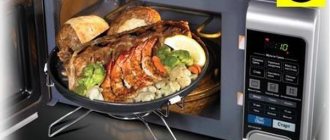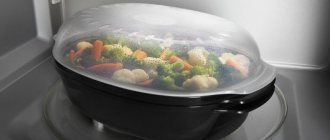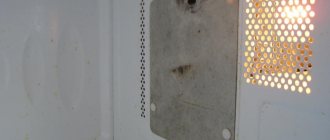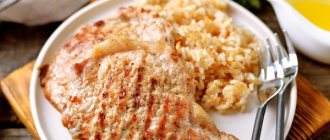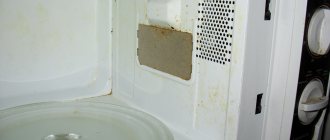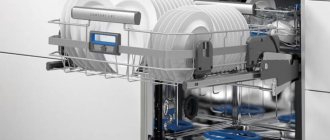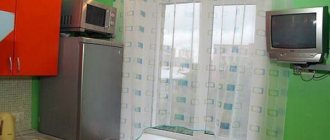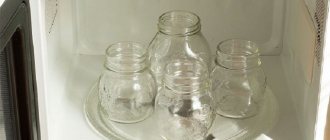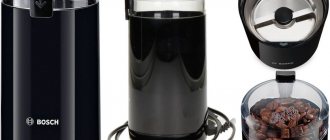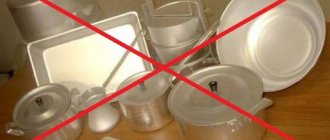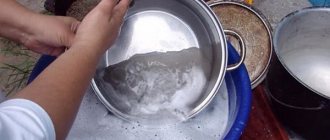Before using a new technique, it is recommended that you first carefully study the instructions. The manufacturer always warns which dishes should not be placed in the microwave. First of all, crystal, melamine and metal are contraindicated for it. If containers made from the listed materials are placed inside, they may deteriorate or damage the device itself. We suggest that you familiarize yourself with the full list of prohibited utensils and products, and also remember the general precautions when cooking in a microwave oven.
How does a microwave oven work?
Surprisingly, the microwave oven is older than many people alive today. It was patented back in 1945 by Percy Spencer, an American engineer. At that time, he worked for the military-industrial company Raytheon and was engaged in the manufacture of radars. One day, absent-mindedly, Spencer placed a sandwich on the switched-on magnetron (an electrical device that generates microwaves) and discovered that it had become hot. The very next year he received a patent for a microwave oven, and in 1947 his invention saw the light of day.
For a long time, microwave ovens caused distrust, were expensive and therefore were not in demand. And even today there are many myths surrounding technology. For example, that microwave radiation allegedly changes the structure of dietary fiber or water, turning them into dangerous carcinogens. In fact, the operating principle of a microwave oven is the dielectric heating of substances containing polar molecules. Microwave energy is not enough to break chemical bonds. Electromagnetic waves cause the movement of molecules, and the resulting friction between them naturally increases the temperature of the substance. In other words, in microwave ovens, normal heating occurs - and nothing more.
Household microwave ovens operate at a frequency of 2450 MHz (within the absorption spectrum of water). The radiation source is a magnetron with a power of 500 W or more. It directs and concentrates high-frequency waves in a metal chamber, where the dishes with food are actually placed for heating or cooking.
How to Use Copper from an Old Microwave
In fact, the extracted metal and parts obtained during the disassembly of the microwave oven can be reused, and a knowledgeable craftsman will obviously not have them lying around on dusty shelves.
First of all, you should find out the condition of the transformer containing copper . If it is working, then you can use it to repair another furnace, or try to sell it to buyers of similar things at the local market. You can also save this part in case the next microwave you purchase breaks down. If it doesn't work, the best option is to use copper from it.
The metal we are looking for can also be used for various purposes. It depends on your own preferences. Let's look at the best options.
Secondary use
In cases where the transformer is inoperative, it can be disassembled and a decent bundle of non-ferrous metal (about 500 grams) can be obtained. But where to use it? Here are some options for reusing mined copper:
- From the seized metal you can create a variety of crafts (for everyone).
- Use it as a rope for drying clothes (the wires are not thick enough, so you will need to twist them in several layers).
- Copper wiring will become useful in the household. For example, they can be used when tying cucumbers, tomatoes and other plants.
- Car enthusiasts will be able to use copper wire for their own purposes. Twist the rings, place nuts or washers on them, and then place them in a visible place in the garage. This storage method is quite convenient, because you can sort the parts by size, and if necessary, you don’t have to search for a suitable one for several minutes.
Why can't everything be heated in the microwave?
The microwave oven requires special handling and safety precautions. During operation, high-frequency radiation is supplied to the camera, which acts completely differently than the fire that is familiar to many. Microwaves are reflected from the metal, which leads not only to its heating, but also to the appearance of an electric arc (lightning, crackling, discharge). The second taboo for a microwave oven is hermetically sealed containers. Under the influence of electromagnetic waves, moisture evaporates very quickly, which entails an increase in pressure in a confined space and an explosion. Packages, containers with lids, and even foods (eggs and others) can explode.
We recommend: Is it possible to heat kefir in the microwave, is it harmful?
List of prohibited materials
It is strictly forbidden to put only 3 types of dishes in the microwave:
- Metal. As already mentioned, metal (brass, iron, copper, cast iron, steel) does not transmit microwaves and causes spark discharges. Using such utensils for heating or cooking in the microwave is extremely dangerous!
- Crystal. There are quite a lot of inclusions of lead, silver and other metals in crystal. In the microwave, the material becomes very hot and shatters.
- Melamine. Melamine dishes are very similar to porcelain, but they are inexpensive and very light. Unfortunately, it melts quickly and, by the way, is unsafe for health. It is absolutely not suitable for use in the microwave.
As usual, any rule has exceptions. You can cook in a shallow metal container if you do not turn on the microwave mode - grill, convection, or a combination of both.
It is prohibited to place not only plates, pots and pans made from the above materials in the microwave. It is important to ensure that no spoon or other cutlery is accidentally left in it.
What should you not use in the microwave?
Any metal utensils are absolutely not suitable for microwaves.
. Steel, copper, brass, cast iron, iron. These materials do not allow microwaves to pass through, so the food in such dishes will not heat up. When metals are in the microwave oven chamber, static spark discharges may occur, which are unsafe for microwave ovens. The magnetron (microwave generator) may fail, an explosion may occur, or a fire may occur.
You can't use dishes in microwave ovens either.
, having metal parts (handles, metal rim, metal fasteners, bolts, paper clips on product packaging, etc.). Do not forget to remove metal spoons, forks, and knives from heated dishes.
Metal spraying
, decoration (pattern) on the dishes made with paint containing metal (for example, a silver rim or a gilded pattern) also makes the dishes unsuitable for the microwave. Even paint on old dishes that has worn off from long-term use can spark and crack.
For the same reason, crystal containers cannot be placed in a microwave oven (crystal contains lead and silver). In addition, the cut surface of the crystal is not uniform in thickness, which can cause the dishes to shatter into pieces.
Do not use plastic utensils
(unless it is specifically designed for a microwave oven), since this material is not resistant to high temperatures. May melt.
Plastic is also a very bad option.
It can easily become deformed and emit an unpleasant odor. But there is also special heat-resistant plastic. Look for special markings on it.
Delicate thin glass transmits microwaves well, but it can break even at not very high temperatures.
Melamine dishes are completely unsuitable
. It looks like porcelain, just as beautiful, but weighs much less. Taking it in your hands, it is immediately clear that this is a completely different material.
Disposable paper tableware will not work either.
. It has a layer of wax on it, which will melt in the oven, get into the food and spoil its taste.
Controversial materials
Some utensils may or may not be suitable for use in a microwave oven. Much depends on the manufacturing technology, additional protective properties, and wall thickness. A special point should be made about the presence of paint and metal decorative elements. Even a completely ordinary-looking dye without shine can contain metal in its composition. Such dishes will become very hot or spark in the microwave, but their contents will remain cold. Coffee mugs and plates with patterns often suffer from this problem.
List of “controversial” microwave cookware:
- Ceramic. Ceramics that are not protected by glaze heat up unevenly and crack when exposed to microwaves. It can be used in a microwave oven only when the glaze completely covers the dish, including the bottom, and there are no slightest chips or cracks.
- Clay, earthenware, porcelain. Like ceramics, clay, earthenware and porcelain are susceptible to cracking. Inside they are heterogeneous and full of internal bubbles. The glaze saves the situation, but still, when cooking, such dishes get very hot. When removing a dish from the microwave, you must definitely use oven mitts to avoid getting burned.
- Bamboo dishes. Manufacturers often mark it as not microwave safe. However, many people successfully heat food in it... up to a certain point. The fact is that bamboo perfectly absorbs water, which evaporates too quickly inside the chamber. Even a slightly damp plate can crack if heated for a long time or at high temperatures.
- Ordinary glass. Glass transmits microwaves better than other materials and can be used to heat food in a microwave oven. However, if the walls of the pan are too thin, it may burst. To avoid this, you should place it in the center, away from the walls of the chamber.
- Plastic. Plastic is not afraid of temperature changes; many people love it because in such a container you can heat food directly from the freezer. However, not all containers are suitable for cooking in a microwave oven. Plastic dishes must have the appropriate microwave symbol and be heat-resistant (withstand temperatures of 130–140 degrees).
- Disposable paper tableware, plastic bags. When contacting hot food, such materials begin to release harmful substances - wax, dyes. Using such containers for cooking is unsafe for health. These are options for extreme cases when you need to quickly reheat or defrost food.
- Foil. Contains metals and does not transmit microwaves well. The only possible use is as a substrate.
We recommend: Rules and nuances of heating food in the microwave
What kind of dishes can I use?
- Utensils made specifically for microwave ovens are made from tempered heat-resistant glass. You can cook in it as much as you want, anywhere. Even in a regular electric or gas oven.
- The second recommended option is silicone molds. High-quality silicone allows microwaves to pass through and can withstand temperatures from -40 to +240 degrees.
- It is also allowed to use parchment paper and a special sleeve for baking fish and meat for cooking in the microwave.
Utensils that can be used in the microwave
In order for the process of cooking and heating in a microwave oven to be high-quality and safe, it is worth acquiring special utensils.
When choosing a container, you should consider not only the material from which it is made, but also the material of the design.
Glass
Heat-resistant glass is allowed to be used in microwave ovens.
Utensils made of thick glass are great for both defrosting and heating. This glass has fire-resistant properties and thick walls. The transparency of the material allows you to monitor the process without opening the door.
The main thing is that the glassware sent to the microwave oven is not chipped or cracked.
Clay
The pottery meets the requirements for use in a microwave oven. But under one condition: the products must be covered with glaze on all sides. It is easier to notice the presence of cracks and chips in the glaze.
Faience
Earthenware utensils can be used to heat food. It is better if it is equipped with thick walls, a uniform color and no damage.
Ceramics
Dense ceramics.
Ceramic containers are quite suitable for use, but they should not have patterns on them. It is especially good to use popular products made from thick ceramics.
But such dishes cannot withstand sudden temperature changes, for this reason there is no need to place a cold ceramic container in a heated cabinet.
Porcelain
The same applies to porcelain products as to ceramics. Porcelain is suitable for microwave use only if it has a glazed coating. Otherwise you shouldn't use it.
Plastic
Microwave plastic.
Plastic is only suitable for heating food. The container must have special markings. The product must withstand up to 140 degrees. However, you should not blindly trust labels.
It is worth buying from reliable manufacturers. If there is no label at all, such utensils, as is already known, cannot be used.
Plastic film
Plastic film, like plastic bags, is quite suitable for microwaves. To prevent the film from tearing from the inside during the heating process, it is necessary to pierce the film in several places before sending the package into the oven.
Disposable items
Such disposable packages made of thick cardboard and parchment paper are allowed for use in the microwave, but you should know that these things, impregnated with wax, make the food unfit for consumption during the heating process.
What foods cannot be put in a microwave oven?
Dishes are not the only taboo for the microwave. Some products cannot be placed in it:
- eggs in shell (explode);
- milk and fermented milk products (heat unevenly, curdle);
- any products in sealed packaging (explode);
- ready-made infant formula (heats unevenly, curdles)
- mushrooms and chicken (they spoil quickly; when frozen, heating is uneven);
- frozen berries (nutrients disappear);
- honey (at a temperature of 40 degrees the product loses its benefits).
General precautions
In addition to the list of prohibited utensils and products for the microwave oven, it is important to remember several important rules for its use.
What not to do?
- Place the dishes close to the walls of the chamber.
- Cook or reheat in a container that sparks. The appliance must be turned off immediately and the plate removed.
- Allow temperature changes - put dishes from the refrigerator into the oven, remove a hot dish onto a cold or wet surface. The exceptions are plastic and silicone.
- Cook or reheat food in a hermetically sealed container. A hole should be provided for steam to escape.
The microwave makes life easier and faster, but it is important to use it correctly. Initially, you need to choose suitable dishes for it. It is not necessary to buy a new one - a special one. Select old glass plates with thick walls, white ceramics without patterns, heat-resistant plastic, silicone molds, parchment - and you can easily and safely prepare many delicious dishes.
